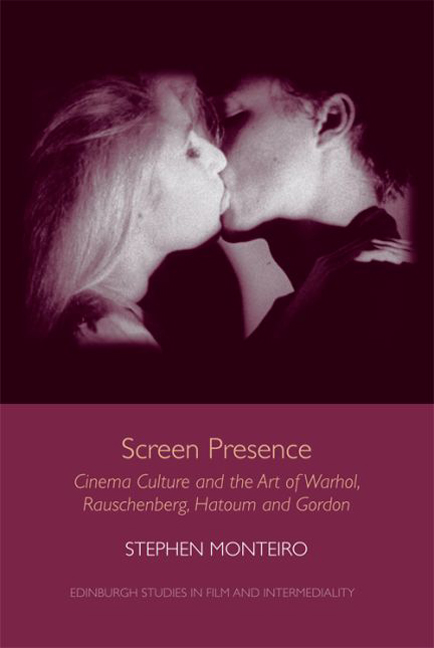Book contents
- Frontmatter
- Contents
- List of Figures
- Acknowledgements
- Introduction: Cinema's Grey Spaces
- 1 A Wider Audience: Robert Rauschenberg, the White Paintings and CinemaScope
- 2 The Screen Scene: Andy Warhol, the Factory and Home Movies
- 3 Private Dis-Pleasures: Mona Hatoum, Mediated Bodies and the Peep Show
- 4 A Monument in Ruins: Douglas Gordon, Screen Archaeology and the Drive-in
- Conclusion
- Index
Conclusion
Published online by Cambridge University Press: 15 September 2017
- Frontmatter
- Contents
- List of Figures
- Acknowledgements
- Introduction: Cinema's Grey Spaces
- 1 A Wider Audience: Robert Rauschenberg, the White Paintings and CinemaScope
- 2 The Screen Scene: Andy Warhol, the Factory and Home Movies
- 3 Private Dis-Pleasures: Mona Hatoum, Mediated Bodies and the Peep Show
- 4 A Monument in Ruins: Douglas Gordon, Screen Archaeology and the Drive-in
- Conclusion
- Index
Summary
There is nothing new about screened images in art spaces today. And why should there be when screens have become a part of nearly every contemporary device and setting, from automobiles and looms to classrooms and bus stands? Nevertheless, this proliferation of screens continues to impact and shape our understanding of art. Some theorists, including Rosalind Krauss, Lev Manovich and Peter Weibel, have claimed that contemporary culture – perhaps especially art – has moved beyond past constraints of medium. Proclamations of a ‘post-media’ era build on corollary discussions such as that of the ‘post-cinema’ in emphasising the difficulty of establishing and maintaining stable boundaries between forms and methods of expression that once seemed autonomous and distinct. Amid these claims of the withering meaning of ‘medium’ at a time when music, film, television, animated games and other content may be accessed through a single device, it must be remembered that the screen remains at the centre of such activity as the most common site of interface for these transactions. To measure the significance of this medium that is the screen, it is important to consider the role that screens and screened images have played for over a century as places of physical, social and ideological interface in diverse cultural contexts.
The relationship between the development of cinema's many forms and the history of modern and contemporary art presents a privileged path in this process. As competing and intersecting realms of visual practice since the late nineteenth century, cinema and art have borne the traits of convergence, hybridity and adaptability often ascribed to today's media culture, long before these became common ways of conceptualising or describing visual media. Indeed, the history of modern art can be regarded as a long struggle to dissolve the often arbitrary and ideological boundaries that had been imposed on varied practices of visual expression while also testing imposed divisions of sensory experience. Space and contingency – both fundamental to cinema – became key points of access in this transformation. Many of the most significant and lasting works in contemporary art have grown out of the cracks opened up by that process. This is the case with the artists considered here.
- Type
- Chapter
- Information
- Screen PresenceCinema Culture and the Art of Warhol, Rauschenberg, Hatoum and Gordon, pp. 181 - 182Publisher: Edinburgh University PressPrint publication year: 2016

